Fabrication and Performance Analysis of the Aero-Leaf Savonius Wind Turbine Tree
Abstract
:1. Introduction
2. Materials and Methods
2.1. Grid Generation
2.2. Numerical Model
2.3. System Design
2.4. Velocity and Pressure Contours
2.5. Construction of Savonius Turbine
2.6. Wind Power Calculations and Power Coefficients Estimation
2.7. Numerical Method Validation
3. Results and Discussion
3.1. Wind Speed Characteristics
3.2. Wind Power at the Site
3.3. Variation of Cp and TSR
3.4. Current and Voltage
4. Conclusions
Author Contributions
Funding
Data Availability Statement
Acknowledgments
Conflicts of Interest
Nomenclature
| CP | Coefficient of power |
| CT | Coefficient of torque |
| VAWT | Vertical Axis Wind Turbine |
| HAWT | Horizontal Axis Wind Turbine |
| cp | Specifc heat, (J/kg-c) |
| C1ε, C2ε, C3ε | Constant |
| g | Gravitational constant, 9.81 m/s2 |
| Gb | Generation of turbulent kinetic energy that arises from buoyancy |
| Gk | Generation of turbulent kinetic energy arises due to mean velocity |
| h | Heat transfer coefcient (W/m2–k) |
| Kf | Thermal conductivity (W/m–k) |
| AR | aspect ratio |
| OR | overlap ratio |
| TSR | Tip Speed Ratio |
| ṁ | Mass fow rate in kg/s |
| Pr | Turbulent Prandtl number |
| ρuiuj | Reynolds stress |
| Ti | Inlet temperature (K) |
| To | outlet temperature (K) |
| XM | The arithmetic average of observations |
| Xi | Number of observations |
References
- Patidar, H.; Shende, V.; Baredar, P.; Soni, A. Comparative study of offshore wind energy potential assessment using different Weibull parameters estimation methods. Environ. Sci. Pollut. Res. 2022, 29, 46341–46356. [Google Scholar] [CrossRef]
- Bp Statistical Review of World Energy. 2022. Available online: https://www.bp.com/en/global/corporate/energy-economics/statistical-review-of-worldenergy.html (accessed on 15 January 2023).
- Power Consumption to Triple by 2050′—McKinsey Report. Available online: https://www.modernpowersystems.com/news/newspower-consumption-to-triple-by-2050-mckinsey-report-9655086# (accessed on 8 January 2023).
- Amano, R.S. Review of Wind Turbine Research in 21st Century. J. Energy Resour. Technol. 2017, 139, 050801. [Google Scholar] [CrossRef]
- Prabhukhot, P.R.; Prabhukhot, A.R. Computer Analysis of S822 Aerofoil Section for Blades of Small Wind Turbines at Low Wind Speed. J. Sol. Energy Eng. 2017, 139, 051008–51011. [Google Scholar] [CrossRef]
- Global Energy Review 2020 by IEA. Available online: https://www.iea.org/reports/global-energy-review-2020 (accessed on 15 January 2023).
- Patidar, H.; Shende, V.; Baredar, P.; Soni, A. Comparative evaluation of optimal Weibull parameters for wind power predictions using numerical and metaheuristic optimization methods for different Indian terrains. Environ. Sci. Pollut. Res. 2023, 30, 30874–30891. [Google Scholar] [CrossRef]
- Patidar, H.; Shende, V.; Baredar, P.; Soni, A. Comparative analysis of wind potential and characteristics using metaheuristic optimization algorithms at different places in India. Int. J. Environ. Sci. Technol. 2022, 1–16. [Google Scholar] [CrossRef]
- Shende, V.; Patidar, H.; Baredar, P.; Agrawal, M. Estimation of wind characteristics at different topographical conditions using doppler remote sensing instrument—A comparative study using optimization algorithm. Environ. Sci. Pollut. Res. 2023, 1–17. [Google Scholar] [CrossRef]
- Shende, V.; Patidar, H.; Baredar, P.; Agrawal, M. A review on comparative study of Savonius wind turbine rotor performance parameters. Environ. Sci. Pollut. Res. 2022, 29, 69176–69196. [Google Scholar] [CrossRef]
- Sonawane, C.R.; Sasar, Y.; Shaikh, M.; Kokande, Y.; Mustafa, M.; Pandey, A. Numerical simulation of Savonius rotors used for low wind speed application. Mater. Today Proc. 2022, 49, 1610–1616. [Google Scholar] [CrossRef]
- Chaudhari, V.N.; Shah, S.P. Numerical investigation on the performance of an innovative Airfoil-Bladed Savonius Hydrokinetic Turbine (ABSHKT) with deflector. Int. J. Thermofluids 2023, 17, 100279. [Google Scholar] [CrossRef]
- Akwa, J.V.; da Silva Júnior, G.A.; Petry, A.P. Discussion on the verification of the overlap ratio influence on performance coefficients of a Savonius wind rotor using computational fluid dynamics. Renew. Energy 2012, 38, 141–149. [Google Scholar] [CrossRef]
- Akwa, J.V.; Vielmo, H.A.; Petry, A.P. A review on the performance of Savonius wind turbines. Renew. Sustain. Energy Rev. 2012, 16, 3054–3064. [Google Scholar] [CrossRef]
- Zemamou, M.; Aggour, M.; Toumi, A. Review of savonius wind turbine design and performance. Energy Procedia 2017, 141, 383–388. [Google Scholar] [CrossRef]
- Youssef, K.; El Kholy, A.M.; Hamed, A.M.; Mahmoud, N.A.; El Baz, A.M.; Mohamed, T.A. An innovative augmentation technique of savonius wind turbine performance. Wind. Eng. 2019, 44, 93–112. [Google Scholar] [CrossRef]
- Saha, U.; Thotla, S.; Maity, D. Optimum design configuration of Savanius rotor though wind tunnel experiments. J. Wind Eng. Ind. Aerodyn. 2008, 96, 1359–1375. [Google Scholar] [CrossRef]
- Fujisawa, N. On the torque mechanism of Savonius rotors. J. Wind. Eng. Ind. Aerodyn. 1992, 40, 277–292. [Google Scholar] [CrossRef]
- Oliveira, C.; Petry, A. Numerical study of a helical Savonius wind turbine. In Proceedings of the 15th Brazilian Congress of Thermal Sciences and Engineering, Belém, Brazil, 10–13 November 2014. [Google Scholar]
- Damak, A.; Driss, Z.; Abid, M. Experimental investigation of helical Savonius rotor with a twist of 180°. Renew. Energy 2013, 52, 136–142. [Google Scholar] [CrossRef]
- Zhao, Z.; Zheng, Y.; Xu, X.; Liu, W.; Zhou, D. Optimum Design Configuration of Helical Savonius Rotor via Numerical Study. In Proceedings of the ASME 2009 Fluids Engineering Division Summer Meeting, Vail, CO, USA, 2–6 August 2009; pp. 1273–1278. [Google Scholar] [CrossRef]
- Korprasertsak, N.; Leephakpreeda, T. Analysis and optimal design of wind boosters for Vertical Axis Wind Turbines at low wind speed. J. Wind. Eng. Ind. Aerodyn. 2016, 159, 9–18. [Google Scholar] [CrossRef]
- Jansuya, P.; Kumsuwan, Y. Design of MATLAB/Simulink Modeling of Fixed-pitch Angle Wind Turbine Simulator. Energy Procedia 2013, 34, 362–370. [Google Scholar] [CrossRef] [Green Version]
- Mohamed, M.H.; Janiga, G.; Pap, E.; Thévenin, D. Optimal blade shape of a modified Savonius turbine using an obstacle shielding the returning blade. Energy Convers. Manag. 2011, 52, 236–242. [Google Scholar] [CrossRef]
- Mao, Z.; Tian, W. Effect of the blade arc angle on the performance of a Savonius wind turbine. Adv. Mech. Eng. 2015, 7. [Google Scholar] [CrossRef]
- Alom, N.; Saha, U.K. Influence of blade profiles on Savonius rotor performance: Numerical simulation and experimental validation. Energy Convers. Manag. 2019, 186, 267–277. [Google Scholar] [CrossRef]
- Kothe, L.B.; Möller, S.V.; Petry, A.P. Numerical and experimental study of a helical Savonius wind turbine and a comparison with a two-stage Savonius turbine. Renew. Energy 2019, 148, 627–638. [Google Scholar] [CrossRef]
- Mandal, A.K.; Rana, K.B.; Tripathi, B. Experimental study on performance improvement of a Savonius turbine by equipping with a cylindrical cowling. Energy Sources Part A Recover. Util. Environ. Eff. 2020, 1–19. [Google Scholar] [CrossRef]
- Siddiqui, M.S.; Khalid, M.H.; Zahoor, R.; Butt, F.S.; Saeed, M.; Badar, A.W. A numerical investigation to analyze effect of turbulence and ground clearance on the performance of a roof top vertical–axis wind turbine. Renew. Energy 2020, 164, 978–989. [Google Scholar] [CrossRef]
- Al-Ghriybah, M.; Zulkafli, M.F.; Didane, D.H.; Mohd, S. The effect of inner blade position on the performance of the Savonius rotor. Sustain. Energy Technol. Assess. 2019, 36, 100534. [Google Scholar] [CrossRef]
- Chowdhury, A.M.; Akimoto, H.; Hara, Y. Comparative CFD analysis of Vertical Axis Wind Turbine in upright and tilted configuration. Renew. Energy 2016, 85, 327–337. [Google Scholar] [CrossRef]
- Ostos, I.; Ruiz, I.; Gajic, M.; Gómez, W.; Bonilla, A.; Collazos, C. A modified novel blade configuration proposal for a more efficient VAWT using CFD tools. Energy Convers. Manag. 2019, 180, 733–746. [Google Scholar] [CrossRef]
- Bhayo, B.A.; Al-Kayiem, H.H. Experimental characterization and comparison of performance parameters of S-rotors for standalone wind power system. Energy 2017, 138, 752–763. [Google Scholar] [CrossRef]
- Carraro, M.; De Vanna, F.; Zweiri, F.; Benini, E.; Heidari, A.; Hadavinia, H. CFD Modeling of Wind Turbine Blades with Eroded Leading Edge. Fluids 2022, 7, 302. [Google Scholar] [CrossRef]
- Mishnaevsky, L.; Hasager, C.B.; Bak, C.; Tilg, A.-M.; Bech, J.I.; Rad, S.D.; Fæster, S. Leading edge erosion of wind turbine blades: Understanding, prevention and protection. Renew. Energy 2021, 169, 953–969. [Google Scholar] [CrossRef]
- Chandrakant, S.; Panchal, H.; Sadasivuni, K.K. Numerical simulation of flow-through heat exchanger having helical flow passage using high order accurate solution dependent weighted least square based gradient calculations. Energy Sources Part A Recover. Util. Environ. Eff. 2021, 1–26. [Google Scholar] [CrossRef]
- Tian, W.; Song, B.; VanZwieten, J.H.; Pyakurel, P. Computational Fluid Dynamics Prediction of a Modified Savonius Wind Turbine with Novel Blade Shapes. Energies 2015, 8, 7915–7929. [Google Scholar] [CrossRef] [Green Version]
- Patel, A.; Soni, A.; Baredar, P.; Malviya, R. Analysis of temperature distribution over pipe surfaces of air-based cavity linear receiver for cross-linear concentration solar power system. Environ. Sci. Pollut. Res. 2022, 1–19. [Google Scholar] [CrossRef] [PubMed]
- Sandhiya, K.; Kaviya, B. Safe bus stop location in Trichy city by using gis. Int. J. Appl. Eng. Res. 2014, 9, 5686–5691. [Google Scholar]
- Jia, R.; Xia, H.; Zhang, S.; Su, W.; Xu, S. Optimal design of Savonius wind turbine blade based on support vector regression surrogate model and modified flower pollination algorithm. Energy Convers. Manag. 2022, 270, 116247. [Google Scholar] [CrossRef]
- Anbazhagan, R.; Satheesh, B.; Gopalakrishnan, K. Mathematical modeling and simulation of modern cars in the role of stability analysis. Indian J. Sci. Technol. 2013, 6, 4633–4641. [Google Scholar] [CrossRef]
- Laws, P. Validating the ideal configuration and mutual coupling effect among Savonius wind turbine clusters using free rotation analysis. Ocean Eng. 2022, 266, 112879. [Google Scholar] [CrossRef]
- Kianifar, A.; Anbarsooz, M. Blade curve influences on the performance of Savonius rotors: Experimental and numerical. Proc. Inst. Mech. Eng. Part A J. Power Energy 2010, 225, 343–350. [Google Scholar] [CrossRef]
- Roy, S.; Saha, U.K. Review of experimental investigations into the design, performance and optimization of the Savonius rotor. Proc. Inst. Mech. Eng. Part A J. Power Energy 2013, 227, 528–542. [Google Scholar] [CrossRef]
- Ohunakin, O.; Adaramola, M.S.; Oyewola, O. Wind energy evaluation for electricity generation using WECS in seven selected locations in Nigeria. Appl. Energy 2011, 88, 3197–3206. [Google Scholar] [CrossRef]
- Ohaji, D.E.; Musa, M.; Momoh, M.; Akpootu, D.O.; Bello, G. Construction and Performance Evaluation ff Two Staged Three Bladed Savonius Vertical Axis Wind Energy Conversion System. FUDMA J. Sci. 2022, 6, 76–88. [Google Scholar] [CrossRef]
- Blackwell, B.; Sheldahl, R.; Feltz, L. Wind Tunnel Performance Data for Two-and-Three-Bucket Savonius Rotors; US Sandia Laboratories Report SAND76-0131; Sandia Laboratories: Springfield, VA, USA, 1977. [Google Scholar]
- Chaurasiya, P.K.; Kumar, V.K.; Warudkar, V.; Ahmed, S. Evaluation of wind energy potential and estimation of wind turbine characteristics for two different sites. Int. J. Ambient. Energy 2019, 42, 1409–1419. [Google Scholar] [CrossRef]

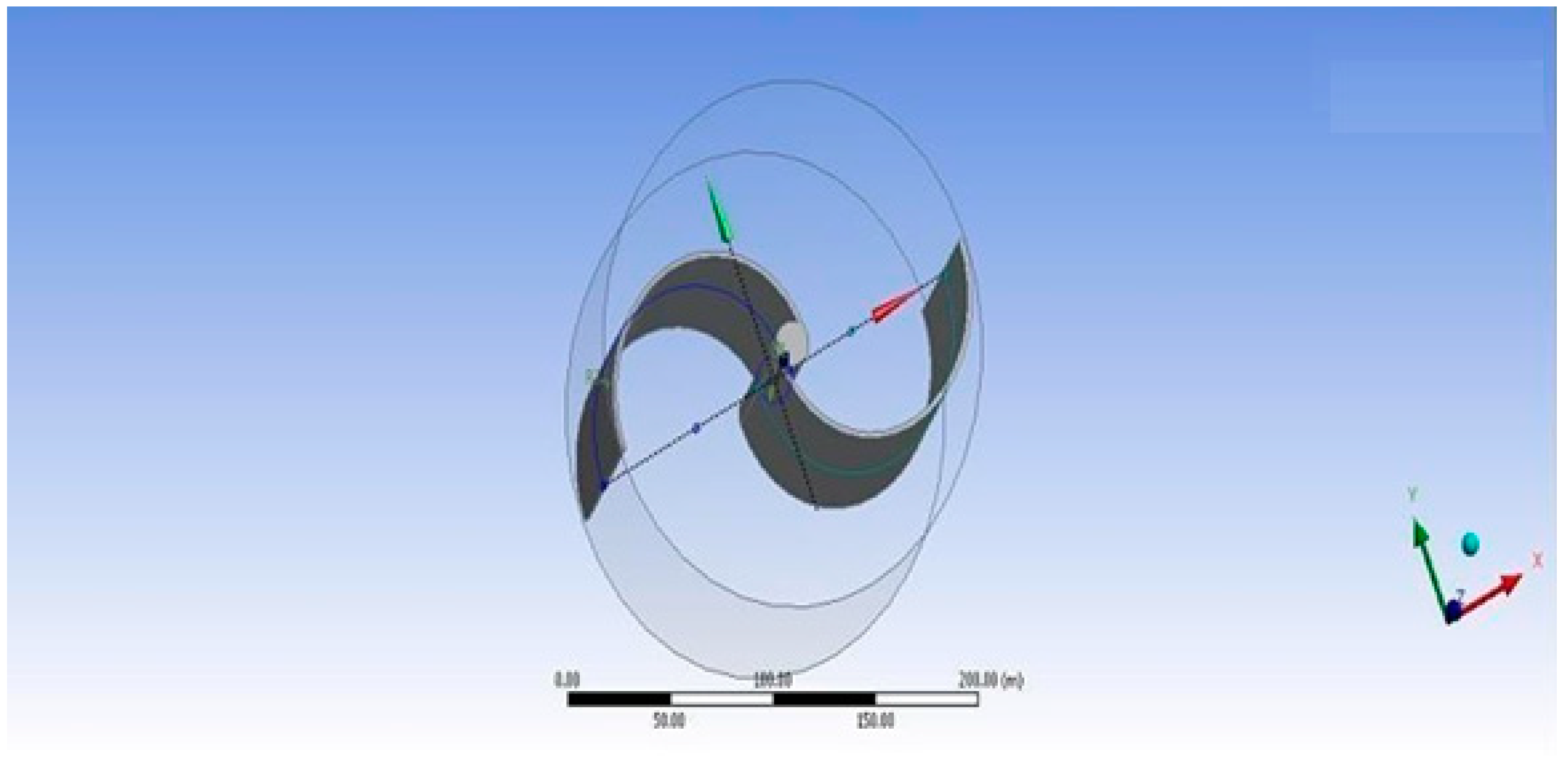

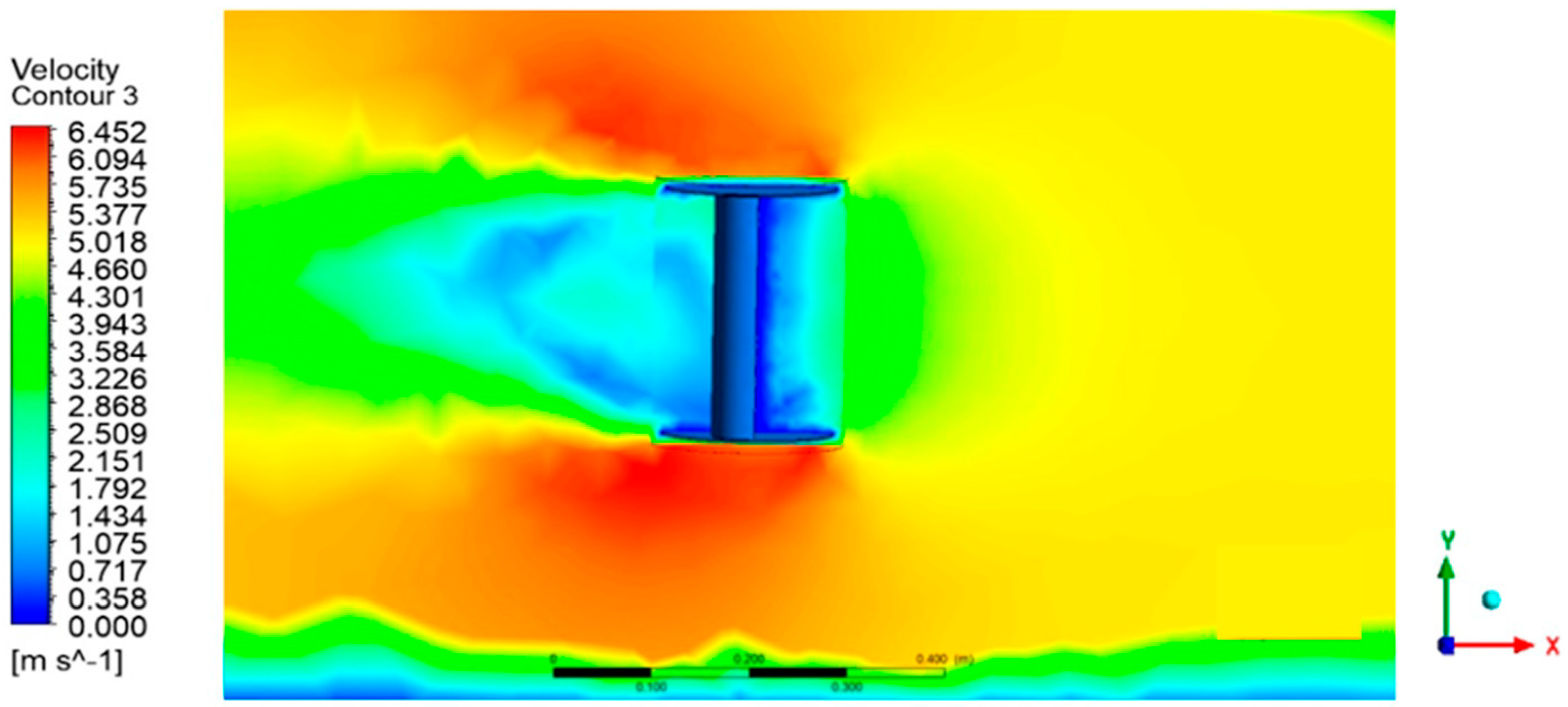


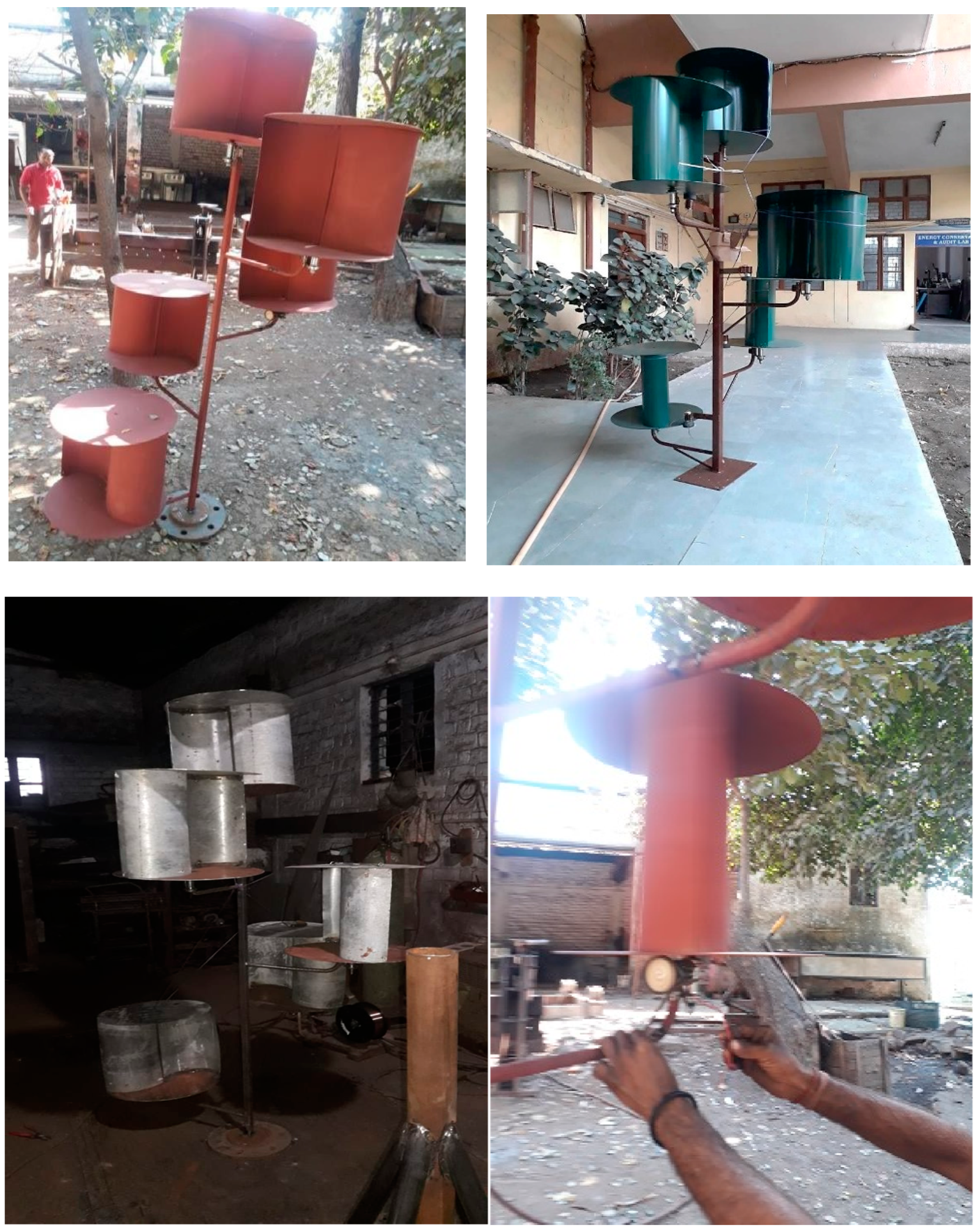


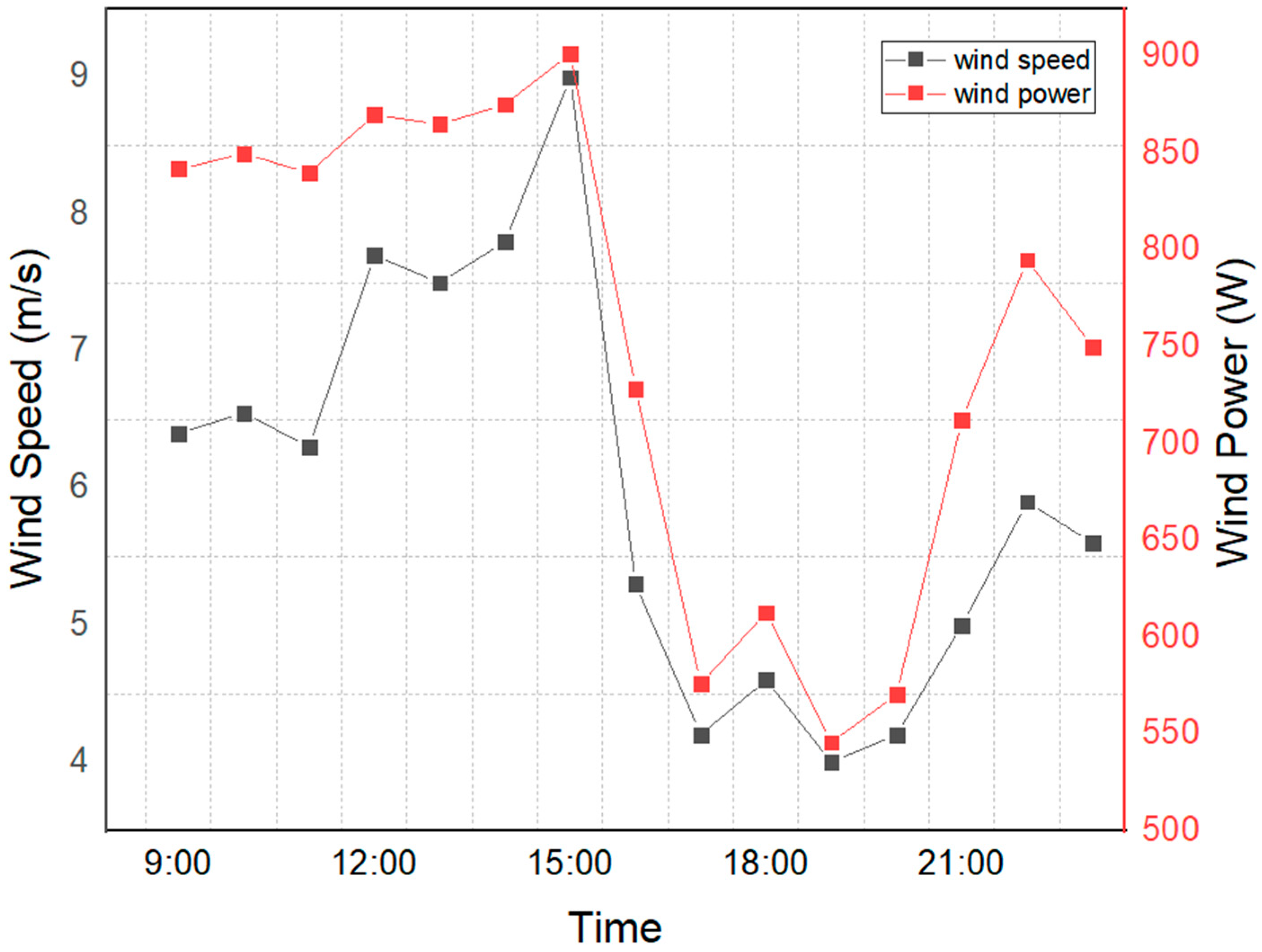
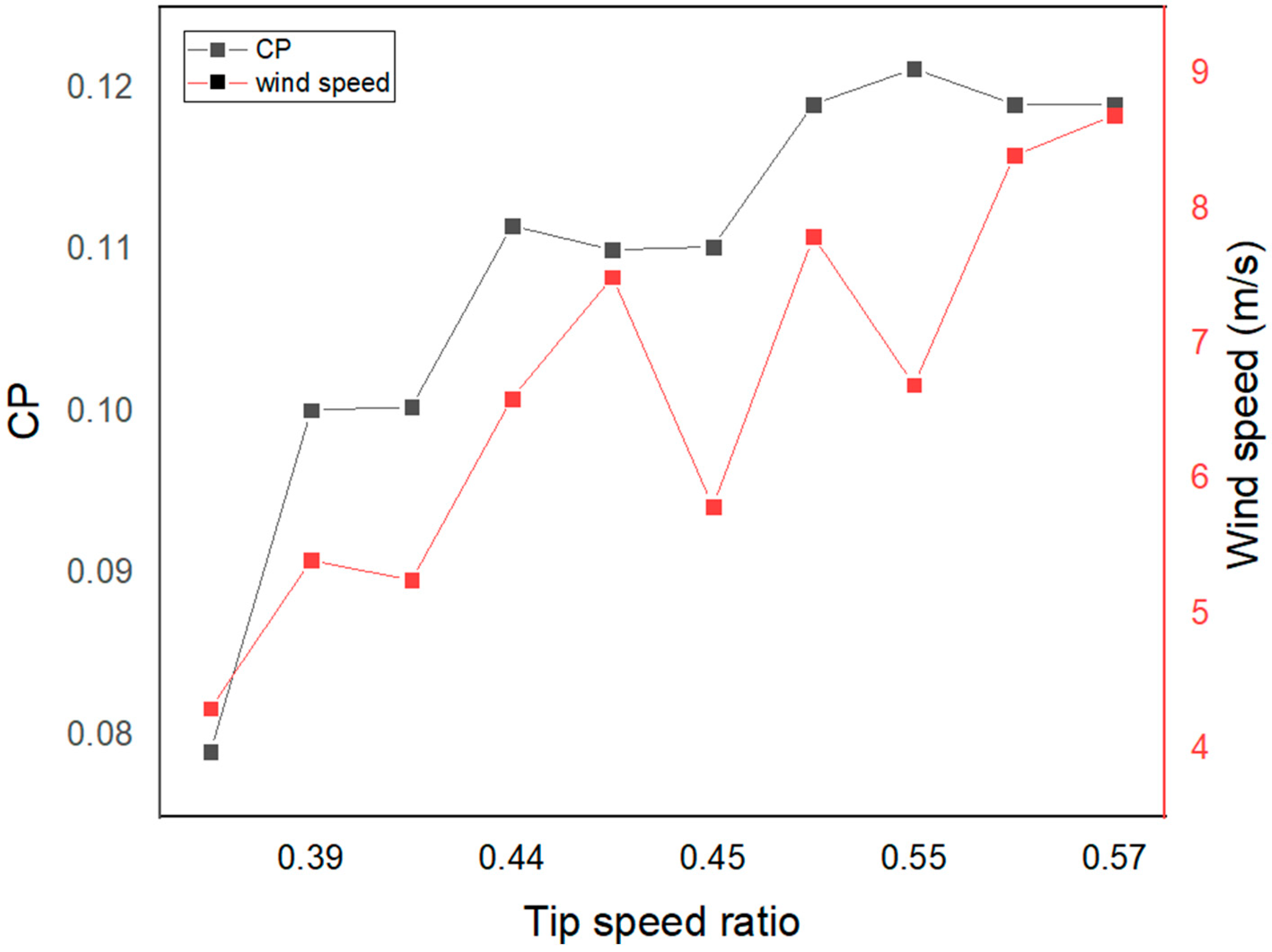

| Ref | Research Activity | Result | Remarks |
|---|---|---|---|
| Amit Kumar Mandal et al. 2020 [28] | The purpose of this study is to create two variants of the Savonius modification and compare their performance. Self-adjusting cylindrical cowlings (CC1 and CC2) are installed on each turbine. | Both cowlings were shown to be effective in increasing the turbine’s output by capitalising on wind currents, but the CC2-fitted rotor proved to be the most productive. | Ca was found to be 53.3% higher in the CC1-modified rotor compared to the control rotor. |
| M. Salman Siddiqui et al. [29] | Here, we conduct parametric research to determine the optimal TI and ground clearance for optimal VAWT performance. Using ANSYS Fluent and the k-turbulence model, we perform detailed computational fluid dynamics (CFD) simulations. | The results show that with a 1:0c clearance height, turbine performance drops by 30.10%, with a 2:5c clearance height, by 10.65%, and with a 4:0c clearance height, by 6.55%. | Mounting at the optimum height, which delivers much fewer ground shearing effects, can greatly improve the performance of rooftop VAWT. Maximum efficiency is achieved with the current turbine at a TSR of 3.0 and a ground clearance of 7:5c, for instance. |
| Mohanad Al-Ghriybah et al. [30] | Here, we employ computational methods to explore how changing the position of the inner blade affects the Savonius rotor, and we conclude that the optimal position is somewhere in the middle. Inner blade angles are standardised at 180 degrees, 160 degrees, 140 degrees, 120 degrees, and 100 degrees. | With the help of the ANSYS-Fluent solver, the k-/realizable turbulence model was used to carry out the simulation. Each case’s predicted torque (Ct) and power (Cp) coefficients are calculated in relation to the tip speed ratio (TSR). At last, the total pressure, velocity, and streamlines are measured and assessed. | When the inner blade is parallel to the rotor tip at an angle of 120 degrees, the numerical results show that the maximum Cp is 0.1885. In addition, the results showed that the rotor with 180° inner blade had the highest Ct at TSR = 0.4, which is 0.407. Not only that, but maximum torque was measured at an azimuthal angle of 105 degrees. |
| Chandrakant R Sonawane et al. [11] | The purpose of this work is to provide the design and numerical analysis of a vertical axis wind turbine suitable for use in low-power urban applications such as wind trees. As a result, three distinct designs of vertical axis rotors are explored statistically in this work, with the goal of absorbing the greatest possible amount of wind energy. | The performance of a Savonius helical bach rotor, a simple Savonius rotor, and a simple bach rotor are all simulated using Computational Fluid Dynamics. These three rotors are analysed for their power output, moment coefficient, and power coefficient. | It is clear that the helical-type Bach rotor outperformed the other two, the simple Saonius rotor and the simple bach rotor. |
| Abdullah Mobin Chowdhury et al. [31] | Computational Fluid Dynamics (CFD) analysis utilising the solution of the Unsteady Reynolds Averaged Navier-Stokes (URANS) equation provides the numerical validation. | It is understood that the optimum time step, mesh dependence analysis, and turbulence model selection are all the result of a rigorous parametric investigation. Validation is carried out when the correct parameters have been selected. The flow fields in both vertical and oblique orientations are then depicted. | When the wake is slanted, the stream of water moves downhill. Tilted VAWTs have the potential to increase the efficiency of floating offshore wind farms by making better use of the available sea surface. |
| Iván Ostos et al. [32] | This paper demonstrates how to enhance a standard Savonius blade’s performance by adding a new configuration without resorting to elaborate and costly alterations to the blade’s geometry. | This is accomplished by a 2D computational fluid dynamic study with Ansys Fluent 18.0, where the Cm and Cp coefficients of 13 different situations are compared to those of the baseline configuration in order to establish a new, more effective configuration. | As the turbulent model, we go with the SST k- model. A Savonius innovative rotor layout is found to be superior to the standard design by a margin of 17.81%. |
| Bilawal A. Bhayo et al. [33] | Seven different Savonius models were subjected to an open wind flow test to investigate how different design parameters affected their overall performance and how they got going. Model 1 through Model 7 denote seven rotors with varying blade designs, blade counts, and stage counts. | As a result of boosting the aspect ratio from 0.77 to 2.0, Model 1 also had a maximum power coefficient that was approximately 47% higher than what had been published in the literature previously. Research has shown that two-stage Savonius rotors have a power coefficient that is 11–20% lower than that of single-stage S rotors of the same design. | Although the power coefficient can be compromised for better starting ability, the study suggests that Model 2’s modified double-stage rotor and Model 5’s conventional double-stage rotor with overlap ratio of 0.2 are the most suitable rotors for stand-alone wind power systems. Neither model displayed any negative torque angle. |
| Wind speed (m/s) | 1.5 | 2.0 | 2.5 | 3.0 | 3.5 | 4.0 | 4.5 | 5.0 |
| Rotational speed (RPM) | 350 | 460 | 520 | 600 | 750 | 880 | 1200 | 1450 |
| S.No. | Time | Wind Speed (m/s) | Voltage (v) | Current (mA) | Power (w) |
|---|---|---|---|---|---|
| 1 | 09:00 | 4.13 | 4.5 | 130 | 0.5850 |
| 2 | 12:00 | 3.06 | 3.78 | 86 | 0.3250 |
| 3 | 03:00 | 5.36 | 5.94 | 210 | 1.2474 |
| 4 | 06:00 | 3.57 | 4.66 | 145 | 0.6757 |
| 5 | 09:00 | 5.68 | 7.38 | 376 | 2.7748 |
| Time | Wind Speed (m/s) | Current (mA) | Voltage (v) | ||||||||
|---|---|---|---|---|---|---|---|---|---|---|---|
| 1 | 2 | 3 | 4 | 5 | 1 | 2 | 3 | 4 | 5 | ||
| 09:00 | 3.88 | 4.74 | 4.90 | 4.15 | 3.68 | 3.73 | 145 | 154 | 109 | 91 | 93 |
| 12:00 | 3.10 | 4.67 | 4.11 | 4.31 | 3.93 | 4.09 | 140 | 100 | 150 | 96 | 98 |
| 03:00 | 2.68 | 5.34 | 3.78 | 3.47 | 4.62 | 3.16 | 184 | 83 | 70 | 130 | 63 |
| 06:00 | 5.47 | 4.10 | 3.27 | 3.79 | 4.23 | 4.02 | 100 | 67 | 75 | 111 | 90 |
| 09:00 | 4.22 | 3.68 | 3.56 | 3.33 | 4.13 | 3.02 | 75 | 72 | 67 | 104 | 73 |
Disclaimer/Publisher’s Note: The statements, opinions and data contained in all publications are solely those of the individual author(s) and contributor(s) and not of MDPI and/or the editor(s). MDPI and/or the editor(s) disclaim responsibility for any injury to people or property resulting from any ideas, methods, instructions or products referred to in the content. |
© 2023 by the authors. Licensee MDPI, Basel, Switzerland. This article is an open access article distributed under the terms and conditions of the Creative Commons Attribution (CC BY) license (https://creativecommons.org/licenses/by/4.0/).
Share and Cite
Rathore, M.K.; Agrawal, M.; Baredar, P.; Shukla, A.K.; Dwivedi, G.; Verma, P. Fabrication and Performance Analysis of the Aero-Leaf Savonius Wind Turbine Tree. Energies 2023, 16, 3015. https://doi.org/10.3390/en16073015
Rathore MK, Agrawal M, Baredar P, Shukla AK, Dwivedi G, Verma P. Fabrication and Performance Analysis of the Aero-Leaf Savonius Wind Turbine Tree. Energies. 2023; 16(7):3015. https://doi.org/10.3390/en16073015
Chicago/Turabian StyleRathore, Mukesh Kumar, Meena Agrawal, Prashant Baredar, Anoop Kumar Shukla, Gaurav Dwivedi, and Puneet Verma. 2023. "Fabrication and Performance Analysis of the Aero-Leaf Savonius Wind Turbine Tree" Energies 16, no. 7: 3015. https://doi.org/10.3390/en16073015
APA StyleRathore, M. K., Agrawal, M., Baredar, P., Shukla, A. K., Dwivedi, G., & Verma, P. (2023). Fabrication and Performance Analysis of the Aero-Leaf Savonius Wind Turbine Tree. Energies, 16(7), 3015. https://doi.org/10.3390/en16073015








